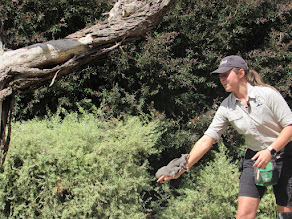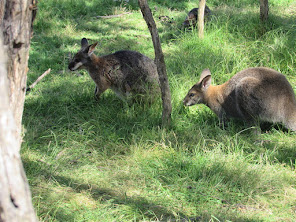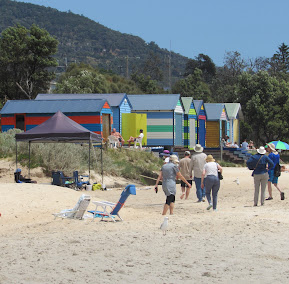Everything in Australia seemed strange to me: the time zone, the latitude, the plants, the animals, the topography. I was literally disoriented not so much from jet lag but in realizing that I was on the other side of the world on another continent. Time played tricks on me as I compared time in Australia with time in Detroit where my sister lives. (I kept in touch with her almost on a daily basis.) It seemed as though today was the future, and yesterday was the present. Nevertheless, it was imperative to stay focused on each day's explorations and discoveries for this was a trip of a lifetime and not one to be wasted on time differences.
One of our most delightful discoveries in Australia was Mornington Peninsula 25 miles south of Melbourne where we saw some of Australia's wildlife. Many of the people in the group had expressed an interest in the animals of Australia--koalas and kangaroos, of course. But we were treated to so much more.
A Little History
Mornington Peninsula was originally occupied by Indigenous Australians of the Mayone-bulluk and Boonwurrung-Balluk clans who lived on the peninsula as part of the Boonwurrung People's territory before the Europeans arrived. About 100–500 of them lived here. In 1803, a penal colony was established here by Lieutenant-Colonel David Collins (1753–1810)--30 years before the founding of Melbourne. The peninsula was covered in she-oaks that were eventually cleared to provide firewood for Melbourne. Fruit orchards replaced them. In recent years there has been a push to preserve the peninsula's natural vegetation and most large areas of bushland that are now part of the Mornington Peninsula National Park. Hobby farming has replaced serious farming by those who have an interest in the natural environment and sustainable practices. Natural bushland with many native species are also protected.
As Melbourne has grown into a major city, Mornington Peninsula has become both a vacation spot and a homeowners refuge for Australians. Tourism has also grown with luxury hotels, campsites, and Airbnbs since 2017 as more and more international visitors come here. And, we were among them during our visit to Moonlit Sanctuary, a 25-acre area preserved for its natural fauna.
Moonlit Sanctuary
As its website states: Moonlit Sanctuary Wildlife Conservation Park grew out of the childhood dreams of Founder and Director Michael Johnson "who imagined a place where people could experience the rare and unusual animals that roam the Australian bush." Each animal has been hand-picked to help halt the rapid extinction of animal species in Australia, and the animals represent 70% of Australia's native fauna.
Of course, when we think of Australia we think of kangaroos. Even Qantas Airlines uses the kangaroo as its logo.
I found the kangaroos rather phlegmatic, but cooperative in letting us go ga-ga over them. Maybe they just feel like "cool cats". The mother (upper left) seems to smile a bit as though motherhood agrees with her.
Young and old enjoyed the opportunity to feed the kangaroos, and even to pet them. They like to be petted on their chests.
The kangaroo's long achilles heel makes hopping its most efficient and agile way of locomotion.
I just love this reclining kangaroo who seems so serene lying on its side, like the reclining women in the art masters' paintings.
Wallabees look a lot like kangaroos only they are smaller, stockier, and their fur is more variegated.
Kangaroos and wallabees are marsupials, which largely live in Australia. They are born as little jelly beans that slowly move into the mother's pouch, attach to her teat, and develop there until mature.
The koala is the other iconic animal associated with Australia. They are so cute that even though they are an endangered species, they will probably not go extinct because of their adorability.

The park allows visitors to pet the koalas and take a portrait with them. It's a little pricey ($25-Aus), though for 5 minutes even at 30% off the American dollar.

Koalas only eat the leaves of the eucalytus tree. They sleep 20 hours a day and are low energy animals because these leaves are a poor nutrient source. They eat, sleep, and mate -- that's it. In the early days of colonization, they were hunted only for their fur and were not a food source.
Urban sprawl is a threat to koalas because the trees they live in are being cut down. Cars are another risk since koalas must cross roads in order to get to another tree. Dogs also are prone to attack them, while bush fires result in huge habitat loss. Many wildlife sanctuaries house koalas, but even that is a controversial issue. Although these sanctuaries help them survive and treat disease (koalas are susceptible to chlamydia), they promote koala tourism, which allows people to touch them. Handling them, however, disrupts their sleep and shortens their lifespans. This controversy then threatens funding the sanctuaries since they are seen as being unfair to the animal's welfare.
A flightless bird, the emu looks like an ostrich, but it is its own bird. It has a small brain and makes a funny noise when it speaks. It does not move backwards, only forwards. That is the reason it is on the Australian coat of arms opposite the kangaroo. As a young nation, Australians believe that moving forward like an emu is the only way to move.
The sanctuary puts on a 30-minute show for visitors. The young women handling the animals were expert in getting them to show their tricks.





The kookaburra has become my favorite bird. It even has a song on YouTube!


The wombat (left) looks like a furry pig. They are nocturnal, like to burrow, and they eat grasses and leaves. The wedge-tailed eagle is on constant alert for moving things to catch and eat.
Being at the sanctuary and seeing the kangaroos brought to mind the song, "Tie Me Kangaroo Down, Sport" by Rolf Harris, 1963.

The Beach at Port Phillip Bay
 The ice cream man cometh to the beach. His colorful truck full of delicious treats were accompanied by happy music. Some members of our group indulged themselves while others just looked around the beach.
The ice cream man cometh to the beach. His colorful truck full of delicious treats were accompanied by happy music. Some members of our group indulged themselves while others just looked around the beach.
Skin cancer in Australia kills over 2,000 people each year with more than 750,000 diagnosed and treated. This is one of the highest national rates of skin cancer in the world. Tanning is embedded in Australian culture, especially among teenagers, but it also increases the risk of developing melanoma. As a result, skin cancer prevention campaigns began in the 1980s with a video like the one below with the seagull.
Resources
https://en.wikipedia.org/wiki/Mornington_Peninsula
https://moonlitsanctuary.com.au/
https://theconversation.com/why-does-australia-have-so-much-skin-cancer-hint-its-not-because-of-an-ozone-hole-91850
https://en.wikipedia.org/wiki/Skin_cancer_in_Australia




































No comments:
Post a Comment